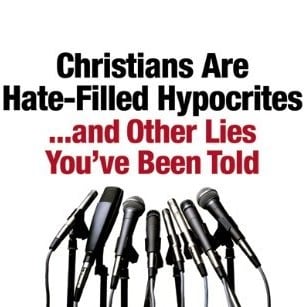 What we think they know and what is true are often at odd, sometimes in ignorant bliss though. This observation alone encourages us to get it right by finding evidence for what we know, or conforming what we know to what we can know on the basis of evidence.
What we think they know and what is true are often at odd, sometimes in ignorant bliss though. This observation alone encourages us to get it right by finding evidence for what we know, or conforming what we know to what we can know on the basis of evidence.
Hence, I’m blogging through Brad Wright’s new book: Christians Are Hate-Filled Hypocrites…and Other Lies You’ve Been Told: A Sociologist Shatters Myths From the Secular and Christian Media
.
.
There are some powerful numbers here (and after the jump). What strikes you?
So, what is this supposed evidence? Brad Wright, who is a professor of sociology and who specializes in American religion, examines four major sources about American religion: The General Social Survey (a most valuable set of data because it has been redone consistently since 1972), the American Religious Identification Survey, the Pew Religious Landscape Survey, and the Gallup polls. He knows how to use this data and assess its reliability and its validity. Which leads to a first big question that Wright examines:
Is American Christianity on the brink of extinction? Some say so…
Christine Wicker once called me before she wrote her book and told me she thought evangelicalism was dying. The iMonk predicted the end of evangelicalism. A friend of mine, a prof, once said we had about 10, maybe 20, years before the end of American evangelicalism. Charles Stanley has offered some strong words this weekend. Pull out apocalyptic language all you want, but first what do the numbers actually tell us.
The opposite: overall, the numbers tell us that American Christianity, especially evangelicalism, is holding its own. Let me mention a few things from this chp and encourage you to get the book and read it yourself.
1. Evangelical numbers have remained about 25% for the entire period. But an increasing number — big time shift (from 200,000 to 8 million) — are nondenominational. But the number of evangelicals has more than doubled since 1972: from 25 million to 60 million. (Catholics and unaffiliated also grew in this time.)
2. The unaffiliated jumped in the 80s and 90s from about 8% to about 15% and have stayed right there since.
3. The mainline numbers have continued to go down since the 70s, and have been going down most of the last century. The numbers since the 70s is that 30% of Americans were mainliners and now only 15% are. Mainliners were the biggest religious group in the USA 3 decades ago, now they are behind Evangelicals, Catholics and the unaffiliated.
4. Black Protestants have stayed right at about 9% since the 70s.
5. Big one: Colonial America was the least religious/Christian period in American history. (Check out his chart on p. 52. Wowzers.) The myth of Christian colonial America continues to makes its way among many. He calculates about 17-18% of Americans in 1775 were affiliated with religion; now it’s just over 60%. The increase has been steady.
The rise of the unaffiliated is connected to the political card that was played in the Regan years through the Christian coalition.
But the big issue is this: being “unaffiliated” is not a sign of a lack of faith, a lack of belief in God, etc. Instead, the unaffiliated expresses the shift in many Americans who don’t want to be connected to a religious institution or to a denomination or go to church. 56% believe in God. Check out his chart on p. 44.
Is the “unaffiliated” the former mainliner?

